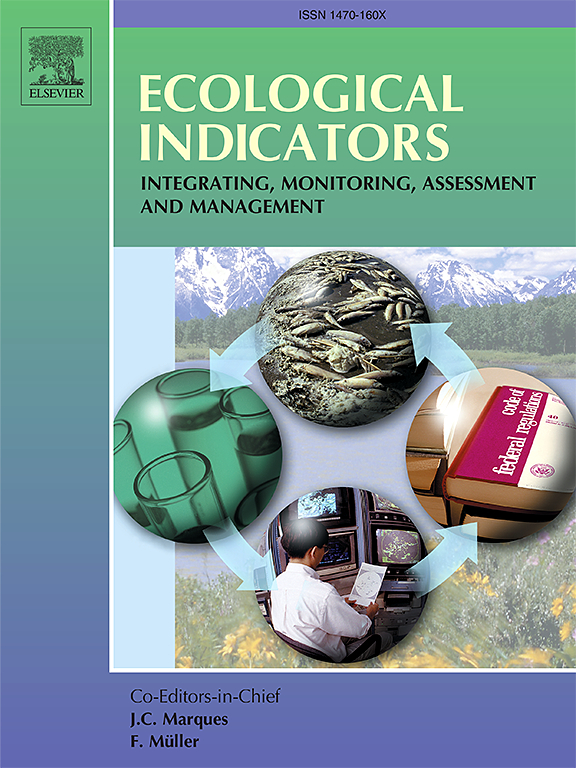IF 7
2区 环境科学与生态学
Q1 ENVIRONMENTAL SCIENCES
引用次数: 0
摘要
沧州市位于河北省,是典型的沿海生态脆弱区和京津冀粮食主产区,在该地区生态经济可持续发展中发挥着重要作用。自然灾害和人为活动的相互作用为该地区的景观生态风险(LERs)带来了更大的可变性和不确定性。评估这些风险并确定其主要驱动因素,对于保障粮食安全、维护生态功能稳定以及实施有效的风险防控战略至关重要。本研究利用 InVEST 模型,定量评估了沧州市 2008 年至 2023 年粮食产量(GP)、碳固存(CS)、水土保持(SC)、水产量(WY)和栖息地质量(HQ)等五项关键生态系统服务功能的损失。它优化了 ESRISK 框架,并采用熵权法-层次分析法(AHP-EWM)构建了未来损失概率指数模型。按照 "损失概率 "框架,研究对 LER 进行了深入评估,并确定了其关键驱动因素。研究结果如下(1)从 2008 年到 2023 年,沧州市五种典型生态系统服务功能的变化相对稳定,但东部沿海和中部城区的生态系统服务功能发生了显著变化。(2)2013-2023 年,沧州市 LER 空间分异特征明显,呈东南部风险较高、西北部风险较低的趋势。极高风险区和高风险区逐年减少,总体风险重心由中低风险向低风险转移,表明区域生态风险总体改善。(3)总体来看,LER 主要受植被覆盖度、单位耕地化肥投入量等因素的影响。从局部来看,盐碱化、植被覆盖率、建设用地比例和农田景观破碎化对 LER 的影响更为明显。这项研究强调了沧州土地退化率的空间变异性和主要驱动因素,为沿海地区的决策和促进可持续发展提供了有价值的见解。本文章由计算机程序翻译,如有差异,请以英文原文为准。
Landscape ecological risk assessment of the northern coastal region of China based on the improved ESRISK framework: A case study of Cangzhou City
Cangzhou City, located in Hebei Province, is a typical ecologically vulnerable coastal area and a major grain-producing region within the Jingjinji area, playing a crucial role in the region’s sustainable eco-economic development. The interplay of natural disasters and anthropogenic activities has introduced greater variability and uncertainty to landscape ecological risks (LERs) in the region. Assessing these risks and identifying their key drivers is essential for safeguarding food security, maintaining ecological function stability, and implementing effective risk prevention and control strategies. This study quantitatively assesses the loss of five key ecosystem services in Cangzhou from 2008 to 2023, including grain production (GP), carbon sequestration (CS), soil conservation (SC), water yield (WY), and habitat quality (HQ), using the InVEST model. It optimizes the ESRISK framework and employs the Entropy Weighting Method − Analytic Hierarchy Process (AHP-EWM) to construct a future loss probability index model. Following a “loss-probability” framework, the research conducts an in-depth assessment of LERs and identifies their key driving factors. The results reveal the following: (1) From 2008 to 2023, the changes in the five typical ecosystem services in Cangzhou City were relatively stable, although significant shifts occurred in ecosystem services within the eastern coastal and central urban areas. (2) From 2013 to 2023, the spatial differentiation characteristics of LER in Cangzhou City were evident, with a trend of higher risk in the southeast and lower risk in the northwest. The areas of extremely high and high-risk levels decreased each year, with the overall risk focus shifting from medium-low risk to low risk, indicating an overall improvement in regional ecological risk. (3) Overall, LER was mainly influenced by factors such as vegetation cover and fertilizer input per unit of cultivated land. Locally, salinization, vegetation cover, the proportion of built-up land, and farmland landscape fragmentation had a more pronounced impact on LER. This study highlights the spatial variability and key drivers of LERs in Cangzhou, providing valuable insights for decision-making and promoting sustainable development in coastal regions.
求助全文
通过发布文献求助,成功后即可免费获取论文全文。
去求助
来源期刊

Ecological Indicators
环境科学-环境科学
CiteScore
11.80
自引率
8.70%
发文量
1163
审稿时长
78 days
期刊介绍:
The ultimate aim of Ecological Indicators is to integrate the monitoring and assessment of ecological and environmental indicators with management practices. The journal provides a forum for the discussion of the applied scientific development and review of traditional indicator approaches as well as for theoretical, modelling and quantitative applications such as index development. Research into the following areas will be published.
• All aspects of ecological and environmental indicators and indices.
• New indicators, and new approaches and methods for indicator development, testing and use.
• Development and modelling of indices, e.g. application of indicator suites across multiple scales and resources.
• Analysis and research of resource, system- and scale-specific indicators.
• Methods for integration of social and other valuation metrics for the production of scientifically rigorous and politically-relevant assessments using indicator-based monitoring and assessment programs.
• How research indicators can be transformed into direct application for management purposes.
• Broader assessment objectives and methods, e.g. biodiversity, biological integrity, and sustainability, through the use of indicators.
• Resource-specific indicators such as landscape, agroecosystems, forests, wetlands, etc.
 求助内容:
求助内容: 应助结果提醒方式:
应助结果提醒方式:


